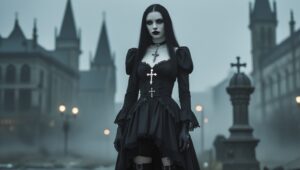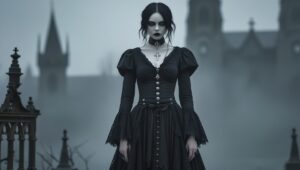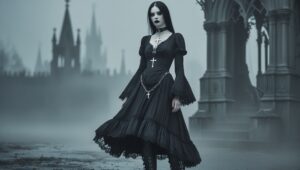
introduction
Gothic fashion is a bold, unique style. It has captivated many, including in the U.S. This fashion style is not about clothing. It’s a culture that loves the mysterious, the dark, and the dramatic. Gothic literature, art, and music inspire it. It has a striking, unique look that stands out in any crowd. Let’s explore the history, key elements, and the influence of Gothic fashion in the U.S.
The History of Gothic Fashion
Gothic fashion originated in Europe during the late 1970s and early 1980s. A strong influence from the Gothic rock music scene shaped this style. Bands like Bauhaus and The Cure led the way. In the U.S., Gothic fashion became popular in the 1980s as the music and style crossed the Atlantic. American cities like Los Angeles, New York, and Chicago became Gothic subculture hubs.
Gothic fashion has evolved over the decades. At first, punk fashion tied itself to leather jackets, spikes, and chains. Over time, it added Victorian and medieval influences. It included lace, corsets, and long, flowing skirts. Today, Gothic fashion in the USA is a diverse, changing style. It blends elements of past eras with modern touches.
Key Elements of Gothic Fashion
People know Gothic fashion for its dramatic and mysterious look. Some of the key elements include:
- Black Clothing: Black is the most common color in Gothic fashion. It symbolizes mystery, elegance, and rebellion. Many Gothic outfits are all black. Other dark shades, like deep purple, burgundy, and dark green, are also popular.
Lace and velvet are often used in Gothic clothing. They have a rich, luxurious look. Lace is common in Gothic dresses and tops. Velvet is often used for jackets and capes.
- Corsets: Corsets are a signature piece in Gothic fashion. They highlight the waist and create a dramatic silhouette, reminiscent of Victorian styles.
- Accessories: Gothic accessories are bold and eye-catching. Common items include chokers, spiked bracelets, long necklaces, and rings. The rings have symbols like skulls, crosses, or bats.
- Makeup: Gothic makeup is an essential part of the look. Pale foundation, dark eyeliner, black or dark red lipstick, and smoky eyes are typical.
- Footwear: Boots are a staple in Gothic fashion. Platform boots, combat boots, and Victorian-style shoes are popular choices.

Gothic subcultures in the U.S.
Over the years, Gothic fashion in the USA has diversified into several substyles. Each subculture has its unique twist on the Gothic aesthetic. Some of the most popular subcultures include:
- Traditional Goth: This style sticks to Gothic fashion’s roots. It focuses on black clothing, dramatic makeup, and Victorian-inspired accessories.
- Cyber Goth: Cyber Goth combines traditional Gothic elements with futuristic and industrial influences. Bright neon colors, PVC clothing, and goggles are common in this style.
- Romantic Goth: Romantic Goth draws inspiration from the Victorian era and Gothic literature. It emphasizes flowing dresses, lace, and elaborate jewelry.
- Steampunk Goth: This subculture blends Gothic fashion and steampunk. It features gears, goggles, and brown leather accents.
- Pastel Goth: Pastel Goth is a modern and playful take on Gothic fashion. It blends Gothic elements with pastel colors. This creates a unique, unexpected look.
Gothic fashion in everyday life
In the USA, Gothic fashion is not limited to clubs or special events. Many people incorporate Gothic elements into their everyday wardrobes. For example, someone might wear a black lace top with jeans. Or, they might accessorize a casual outfit with a choker or skull-themed jewelry. This lets individuals show their Gothic style while mixing it with mainstream fashion.
The Influence of Gothic Fashion on Pop Culture
Gothic fashion has had a significant impact on American pop culture. The Gothic aesthetic is now mainstream, thanks to movies, TV shows, and celebrities. Tim Burton’s films, like The Nightmare Before Christmas and Beetlejuice, have Gothic visuals. They’re well known for this. Morticia Addams from The Addams Family and Lydia Deetz from Beetlejuice are iconic Gothic characters.
Musicians have also played a significant role in popularizing Gothic fashion. Artists like Marilyn Manson, Siouxsie Sioux, and Robert Smith are Gothic style icons. Their bold, unconventional looks inspire fans to embrace the dark and dramatic.
The Role of Gothic Fashion in Self-Expression
For many people, Gothic fashion is more than a style; it’s a way to express their identity. It lets individuals stand out and embrace their love for the mysterious and unconventional. Gothic fashion often attracts people who feel like outsiders or who drawn to the beauty in darkness.
Gothic Fashion Events and Communities
The USA is home to many events and communities that celebrate Gothic fashion. Events like the Gothic Cruise and Wave-Gotik-Treffen draw Gothic fans from across the country.
Online communities also play a significant role in bringing Gothic fashion lovers together. Instagram and TikTok are full of Gothic influencers. They share outfits, makeup tips, and DIY projects. These platforms have helped Gothic fashion reach a broader audience and inspire new generations.
Challenges and Misconceptions
Despite its popularity, Gothic fashion often faces misconceptions. Some see the style as negative or rebellious. They misunderstand its artistic and cultural roots. Gothic fashion fans seek creativity, self-expression, and a love for the dramatic.
Another challenge is finding affordable Gothic clothing. Many Gothic pieces are handmade or from small designers. This can make them expensive.
The Future of Gothic Fashion in the U.S.A.
Gothic fashion continues to evolve and thrive in the USA. The Gothic aesthetic still inspires designers, artists, and individuals. It’s despite new subcultures and trends. With social media and online shopping, it’s now easier than ever to explore and adopt this unique style.
conclusion
Gothic fashion in the USA is a vibrant culture. It celebrates individuality, creativity, and a love for the mysterious. From its roots in Gothic rock to today, this style has shaped fashion and pop culture. From black lace to pastel twists, Gothic fashion still inspires.

